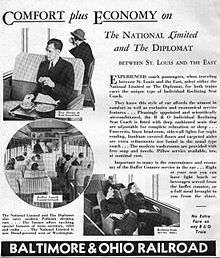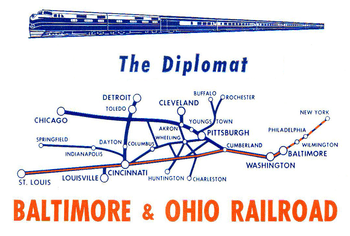Diplomat (train)

The Diplomat was a named passenger train of the Baltimore and Ohio Railroad (B&O) during the 1920s–1950s connecting New York City, and St. Louis, Missouri, via Washington, D.C. Other B&O trains on the route during that period were the premier National Limited and the workhorse Metropolitan Special. The train was inaugurated in August 1930 after several changes to trains along the St. Louis Route. After World War II, the Diplomat operated as Train No. 3 westbound, and No. 4 eastbound. It was timed to provide connections to several western railroads that terminated in St. Louis, including the Frisco, the Santa Fe, Cotton Belt and Missouri Pacific, among others.
B&O's New York terminal was actually in Jersey City, New Jersey, using the New Jersey Central's terminal Jersey City Terminal. Passengers were then transferred to buses that met the train right on the platform. These buses were then ferried across the Hudson River to Manhattan, where they proceeded to various "stations" including the Vanderbilt Hotel, Wanamaker's, Columbus Circle, and Rockefeller Center, as well as Brooklyn.[1]
Route and schedule

In 1947, westbound Diplomat Train # 3 operated on the following schedule (departure times at principal stops shown):
| City | Departure time |
|---|---|
| New York (Rockefeller Center) | 1:15 p.m. |
| New York (42nd Street Station) | 1:25 p.m. |
| Brooklyn, NY | 1:20 p.m. |
| New York (Columbus Circle Station) | 1:20 p.m. |
| Jersey City, NJ | 2:15 p.m. |
| Elizabeth, NJ | 2:32 p.m. |
| Philadelphia, Pa. | 3:58 p.m. |
| Wilmington, Del. | 4:27 p.m. |
| Baltimore, Md. (Mt. Royal Station) | 5:46 p.m. |
| Baltimore, Md. (Camden Station) | 5:54 p.m. |
| Washington, D.C. (Union Station) | 7:00 p.m. |
| Cincinnati (Union Terminal) | 8:05 a.m. |
| Louisville, Ky. | 10:35 a.m. |
| St. Louis (Union Station) | 2:55 p.m. |
| source: Baltimore and Ohio System Timetable, July 6, 1947[2] | |
After the B&O's discontinuation of passenger service to New York on April 26, 1958, the eastern terminus of the Diplomat was Washington, D.C.. Unfortunately, the B&O was never in a position to directly compete against the much faster and more populous routes the New York Central and Pennsylvania Railroad trains used between New York and St. Louis. Instead, the B&O concentrated on service, and won consistent loyalty from business travelers and the general public alike. However, the B&O suffered from a lack of large population centers along the route. Only Cincinnati, Ohio, represented a truly large city big enough between Washington and St. Louis that could add a significant amount of passenger traffic.
The B&O discontinued service between Cincinnati and Baltimore on September 17, 1960, leaving a rump train between St. Louis and Cincinnati. The B&O discontinued the train altogether on April 30, 1961, leaving the National Limited to handle passengers on the route.[3]
The Diplomat was equipped with a dining car, lounge car, and Pullman sleeping cars, in addition to coaches.
References
- ↑ Harwood, Herbert H., Jr. (1990). Royal Blue Line. Sykesville, Md.: Greenberg Publishing. ISBN 0-89778-155-4.
- ↑ Baltimore and Ohio System Timetable. Baltimore: B&O Press. July 6, 1947. p. 9.
- ↑ Welsh, Joe (2007). Baltimore & Ohio's Capitol Limited and National Limited. Saint Paul, Minnesota: Voyageur Press. p. 127. ISBN 978-0-7603-2533-9.
